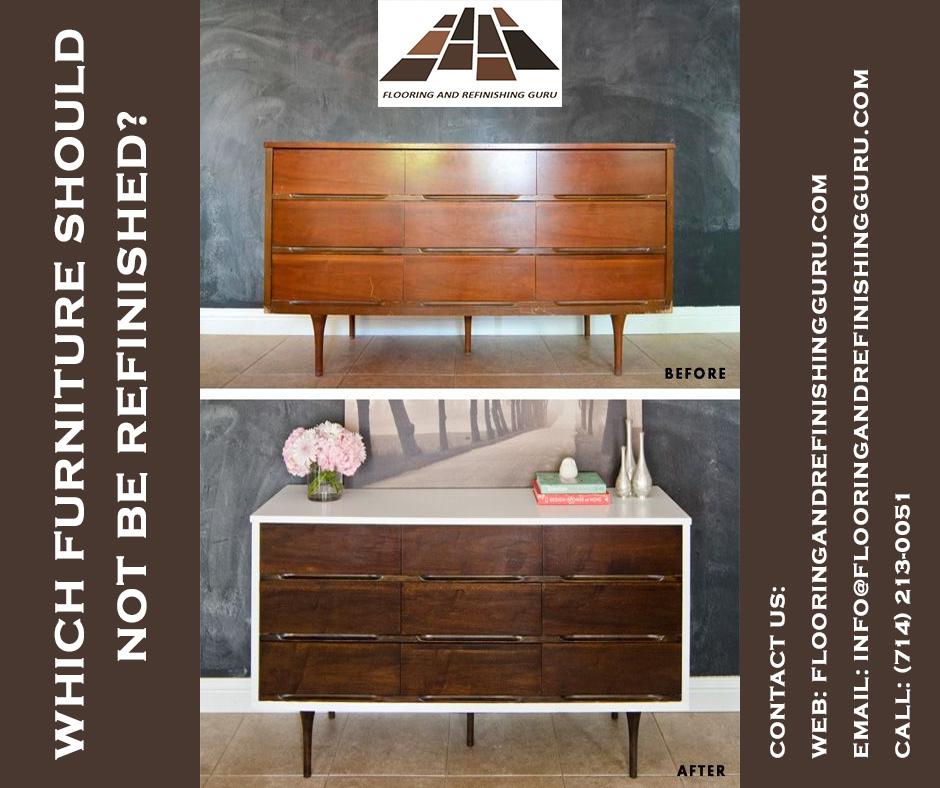
Refinishing furniture can be a rewarding endeavor, breathing new life into worn-out pieces and enhancing the aesthetics of a living space. However, not all furniture types should undergo the process of refinishing: Discover the magic of furniture refinished to perfection. Elevate your space with renewed beauty and functionality. Specific fixtures possessing inherent historical, aesthetic, or material value can be compromised.
Let’s discuss!
Antique Furniture
Antique furniture bear the marks of time, including patina, scratches, and worn finishes, which contribute to their authenticity. The refinishing process can strip away its distinguishing characteristics, diminishing the value and historical relevance. Instead, a gentle restoration approach that involves cleaning, repairing, and preserving the existing finish is recommended to maintain the furnishing.
Read More
What’s the Difference Between Resurfacing and Refinishing?
What is Wood Primer?
Is Cork Flooring Waterproofing?
Art Deco and Mid-Century Modern Furniture
Furniture from the Art Deco and Mid-Century Modern eras has gained popularity for its sleek lines, innovative designs, and distinct finishes. Refinishing can alter the original finishes and color palettes that define these styles, reducing authenticity and attraction. While minor touch-ups and repairs are acceptable, complete refinishing may compromise the essence.
Inlaid and Veneered Furniture
Furniture with intricate inlays and veneers showcases exceptional craftsmanship. Refinishing pieces can damage or weaken them. The refinishing process (sanding, stripping, and painting) expose the underlying layers and causes irreversible harm to the decorative elements. Careful restoration preserves the original veneers and inlays to retain the artistic essence of these items.
Rustic and Distressed Furniture
Rustic and distressed furniture derives its charm from weathered appearance. The imperfections, dents, and cracks are integral to its aesthetic appeal. Refinishing furniture can alter the unique attributes. Instead, opt for techniques that stabilize the piece while maintaining its appearance.
Hand-Painted Furniture
Hand-painted furniture exhibits intricate designs and artistic details. Applying the refinishing process can strip away the hand-painted motifs, affecting the efforts of skilled artisans and the overall visual impact. If the existing paint is deteriorating, a professional restorationist can touch up and protect the original artwork without opting for the refinishing process.
Furniture with Historical Significance
Certain furniture pieces bear historical significance due to their association with notable events, individuals, or periods. Refinishing pieces can erase the physical connections to history, diminishing their value as tangible artifacts. In cases where restoration is needed, preserving the original finish and historical context should take precedence over extensive refinishing.
Read More
How to Paint Raw Furniture?
How to Maintain Hardwood Floors?
How to Check the Durability of Hardwood Floors for Refinishing?
Solid Wood Furniture with Unique Grains
Furniture made from solid wood possesses distinct grain patterns that contribute to its character. Refinishing involves aggressive sanding, a process that can tarnish the uniqueness of the fixtures, especially the grains. To avoid it, opt for careful cleaning and repair. Moreover, apply a protective finish to retain the wood’s natural beauty.
Does Refinishing Furniture Decrease Value?
Refinishing furniture can potentially decrease value, particularly with antique pieces. The original patina, finishes, and wear tell an impressive story of the item’s life. And, preserving the fixture becomes all the more important. Skilled restoration that preserves the original finish can maintain or enhance value by reviving the piece without compromising its attraction.
Conclusion
While refinishing furniture can be a tempting way to revitalize the décor, there are specific categories that should not undergo a harsh treatment with tools and equipment. Antique furniture, pieces from distinct design eras, inlaid or veneered items, rustic and distressed pieces, hand-painted furniture, historically significant items, and furniture with unique wood grains are some examples.
Preserving the authenticity, historical context, and artistic integrity of such fixtures should be a priority. When considering restoration or refurbishment, consulting with professional conservators or restoration experts is essential to ensure that the furniture’s charm and value are upheld for generations to come. Remember, the beauty of furniture lies in its imperfections!
For more information, contact Flooring and Refinishing Guru, the best flooring and refinishing company in the USA.

